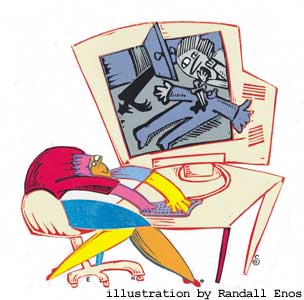![]()
Winter
1999

 Stories
of murder and
mayhem are among the most sought-out
forms of literary fiction today; industry experts guess
that one of every five or six novels published is a mystery,
detective, or crime story. Perhaps the appeal lies in the
intellectual involvement of tracking scattered clues, which
engages readers in ways that other commercial fiction cannot,
or the addictive, open question of "whodunit" which lingers
from beginning to the bittersweet end.
Stories
of murder and
mayhem are among the most sought-out
forms of literary fiction today; industry experts guess
that one of every five or six novels published is a mystery,
detective, or crime story. Perhaps the appeal lies in the
intellectual involvement of tracking scattered clues, which
engages readers in ways that other commercial fiction cannot,
or the addictive, open question of "whodunit" which lingers
from beginning to the bittersweet end.
Once tailored to an audience of 30- to 60-year-old women, mystery novels now attract just as many men. One mystery-bookstore owner attributes this to our search for respite from the real world: in mysteries, the villain always gets punished. Other experts believe that the successes of authors Patricia Cornwell, Mary Higgins Clark, and Sue Grafton have moved modern-day mysteries into the mainstream, and therefore a wider market.
readers of her respected Lydia Chin/Bill Smith mystery series. Rosan, as it turns out, is among three well-reviewed mystery writers with Oberlin roots. Sara Hoskinson Frommer '58 indirectly discovered the connection at a mystery writers conference this year, where her novel Murder and Sullivancaught the attention of Marcia Dutton Talley '65.
"There's something satisfying about a story with a beginning, a middle, and an end in which justice wins out," says Frommer. "A mystery, at least my kind of mystery, is that kind of story." A viola player with the Bloomington Symphony Orchestra, Frommer waited until 1986 to publish her first novel, Murder in C Major,motivated in part by a fellow musician. "One day a particularly irritating oboe player brought murder to mind," she said. "When my husband Gabe came home with an issue of Scientific American featuring Japanese pufferfish on the cover, I discovered a poison strong enough to kill someone.
"Gabe and I cooked up a plan worthy of a doctoral dissertation in neurophysiology that gave me a way to make this esoteric poison available in Oliver, the little town in southern Indiana where all my books are now set," she said. "I finally killed off that oboe player in my first published mystery."
Talley, meanwhile, spent ten years quietly cataloguing rare books at St. John's College. She earned her MLS degree and worked for the next 15 years in Washington, D.C., clawing her way up to the near pinnacle of her profession as a GS-14 department head at the U.S. General Accounting Office Library.
"I undoubtedly got my start writing mysteries when I had the urge to kill the witch who married my father," Talley jokes. "My mother had died and my father had remarried in haste but didn't live long enough to repent at leisure. That first novel is in a drawer, fortunately, so I'm still out of jail, but it was totally therapeutic to bump that woman off in the first paragraph."
Rosan, who made her novel debut in 1994, says she rose through the ranks of a left-wing, progressive architecture firm, and by 1988 was just where she wanted to be: a senior associate handling socially useful projects such as the 41st Precinct in the Bronx and the Women's Rights National Historical Park in Seneca Falls, New York. "That life was exactly what I wanted, but it wasn't making me happy. There was still this voice in my head reminding me of all the dark things that were going on in the world. So I decided to go back to this idea I'd had of writing a crime novel."
Rosan's series of six books to date features an American-born Chinese private eye, Lydia Chin, and her partner, Bill Smith, an aging, white classical pianist. "One of the great things about writing in alternating voices is that they can each be a terrifically exaggerated part of me. Lydia Chin is me as I was--energetic, optimistic, ready to save the world. Bill Smith is me as I am--darker, more tired, knowing that in most cases the war is over and the good guys lost."
Talley's first-person novels feature protagonist Hannah Ives, a much more autobiographical heroine than she cares to admit. "Like me, she is a breast cancer survivor who enjoys sailing and is married to a professor at the Naval Academy. She's funnier than I am, though, and braver. I made Hannah a French major at Oberlin, but it's the lock-picking skills she learned in Dascomb that turned out to be helpful to her in one of the books."
(on to next page)